Episode 169: STS-94 - Deja Crew (MSL-1 Reflight)
Table of Contents
The crew, payload, and orbiter of STS-94 have unfinished business in low earth orbit thanks to a busted fuel cell on STS-83. Let’s kick the tires, light the fires, and then light around 200 more fires, but carefully.
Episode Audio #
Photos #
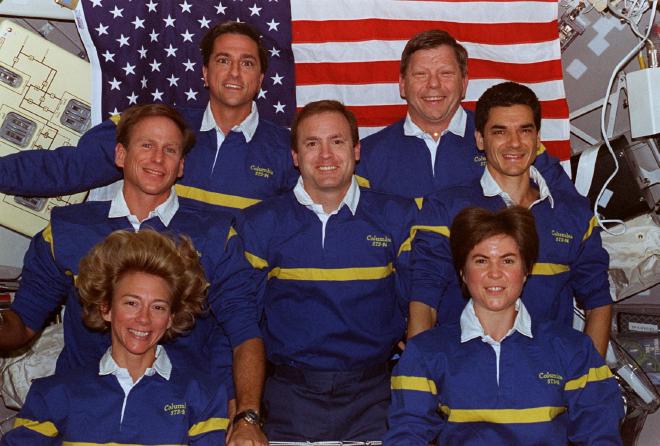
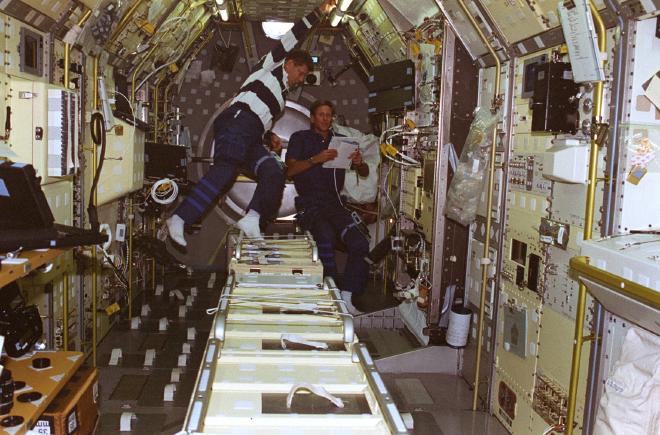
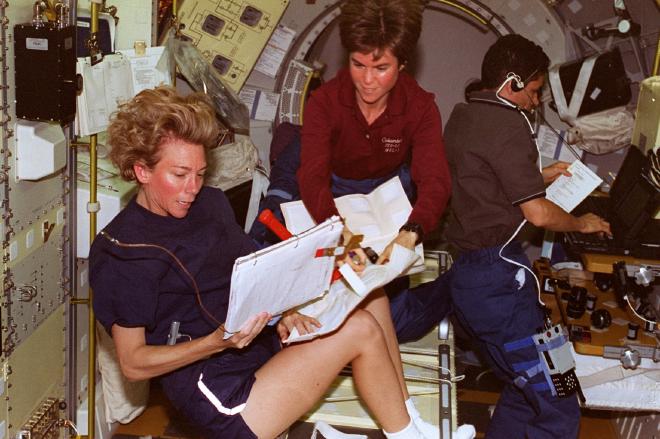
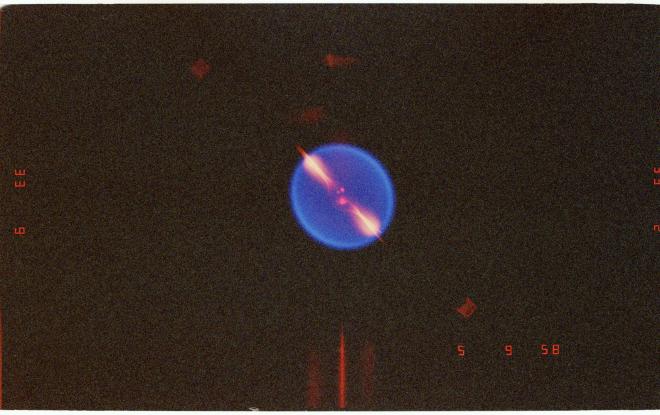
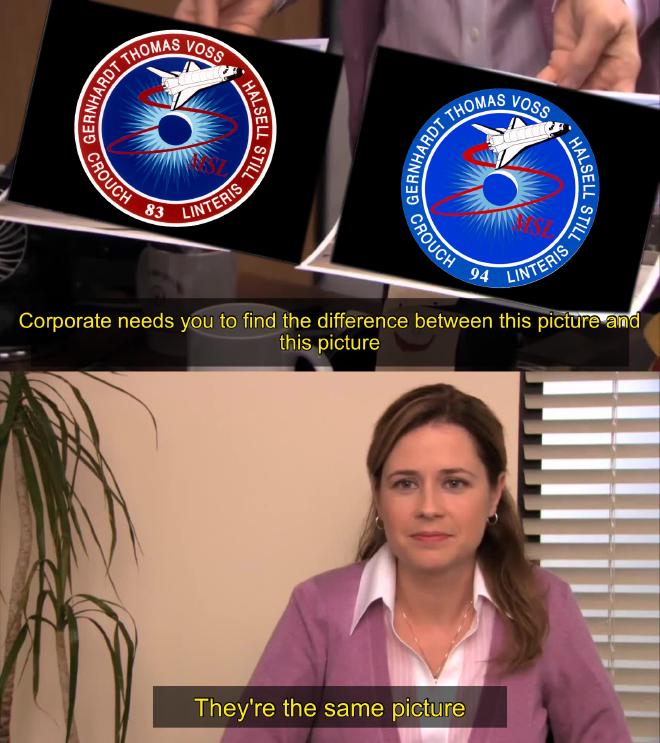
Post-Flight Presentation #
If you’d like to see the mission in motion you can check out the post-flight presentation here:
Transcript #
NOTE: This transcript was made by me just copying and pasting the script that I read to make the podcast. I often tweak the phrasing on the fly and then forget to update the script, so this is not guaranteed to align perfectly with the episode audio, but it should be pretty close. Also, since these are really only intended to be read by myself, I might use some funky punctuation to help remind myself how I want a sentence to flow, so don’t look to these as a grammar reference. If you notice any egregious transcription errors or notes to myself that I neglected to remove, feel free to let me know and I’ll fix it.
Hello, and welcome to The Space Above Us. Episode 169, Space Shuttle Flight 85, STS-94: Deja Crew
Last time, we wrapped up our coverage of NASA’s fifth long duration stay on the Russian space station Mir. Despite arguably being there for the worst that the Shuttle-Mir program had to offer, Foale came through his mission intact and actually seemed to have a pretty good time while he was at it. Say what you will about NASA-5, but you certainly can’t call it boring. Foale landed back on Earth in October of 1997, but we now need to roll the clock back to July as we catch up with the shuttle flights that took place during Foale’s lengthy stay on orbit. But actually, to do that properly, we’ll have to roll the clock back just a bit little further.
In April of 1997 we saw the launch of a mission that had the goal of serving as a bridge between the relatively short term materials science flights of the space shuttle and the arbitrarily long experiments on the upcoming International Space Station, where experiments could stay in weightlessness indefinitely. STS-83 had some lofty goals, a Spacelab full of experiments, and an enthusiastic crew ready to work around the clock to crank out as much science as possible. Unfortunately, it also had a busted fuel cell. As we covered in extreme detail on Episode 165, even including crew procedures and switch locations, substack 3 of fuel cell 2 had a small flaw, detected through the steadily increasing voltage differential reported by the cell performance monitor. Before long it became apparent that the fuel cell would not stabilize and the crew were forced to shut it down and commit themselves to a minimal duration mission.
Just a couple of days into a mission planned to last over two weeks, the crew found themselves scrambling to collect as much data as possible in as short a time as possible and with a limited electrical budget. In the end, rather than the planned mission duration of 15 days and 16 hours, STS-83 clocked in at just under four days total. Despite the crew getting a lot done in their brief stay in low earth orbit, the mission was a failure.
As our dejected crew exited Space Shuttle Columbia on the Shuttle Landing Facility runway, mission commander Jim Halsell was approached by Kennedy Space Center director Roy Bridges. Bridges shook Halsell’s hand and told him that they were going to try to just give Columbia an oil change and send them right back. Three days later it was made official, when Space Shuttle Program Manager Tommy Holloway announced that STS-83 would indeed be reflown. The crew took a week long vacation and then dove right back into the training regimen, preparing to fly again in the not too distant future on STS-83R, soon renamed STS-94.
STS-94 is a remarkable flight because it represents the only true mission reflight of the entire shuttle program. STS-94 would have the same primary payload, the same crew, and the same orbiter, all doing the same thing. We’ve never seen this before and we won’t see it again in the 50 flights to come. Oh by the way, only 50 flights left. Where does the time go?
Other than being a neat bit of trivia, this reflight is interesting because it can serve as a sort of baseline reference for the absolute minimum a shuttle flight could cost. As you’ll recall, the Space Shuttle was developed in the 1970s with promises of rapid and affordable access to space. We would be launching every week or so out of multiple launchpads across the country, maybe even making NASA a self-sufficient agency as it charged private corporations to fly their payloads to orbit. Of course, while the shuttle ultimately delivered on many of its promises and was an incredible flying machine, frugality was not one of its strong suits. I’m not sure if these numbers are adjusted for inflation but since it’s a relative thing it doesn’t really matter.. in Ben Evans’ book “The 21st Century in Space” he points out that a typical shuttle mission cost something like $500 million dollars. But this flight.. this flight only cost $63.3 million. How? Where did that 436 million dollars come from?
It turns out that a huge part of the cost of flying the shuttle, nearly 70%, came from planning, management, and concept-unique logistics. Up until now, no two shuttle missions had been the same, which is part of what makes it fun for us to learn about, but it also meant that there was no such thing as routine. Each flight required special handling, with new mission-specific hardware being designed and manufactured, new mission-specific procedures being written and verified, new mission-specific software being developed and tested, and the crew going through months of mission-specific training, all with layers of management in between making sure the right people were doing the right thing in the right place at the right time. And all that is before we even touch the Orbiter itself. With each unique payload the Orbiter’s payload bay would have to be reconfigured to accommodate it, and then the various payloads would be loaded into the payload bay and middeck, which delicate and specialized process.
But with STS-94 we have this really weird situation. We don’t have to make or install any new mission-specific hardware because we already made it for STS-83. We don’t need new procedures or to plan any new logistics or to train a new crew from scratch. We already did all that stuff. All we need to do are some basic checks and minor servicing, stack Columbia back on an External Tank and SRBs, and roll it back to the pad. The result is that the flight was 8 times cheaper than usual.
But that’s not to say that nothing was done for STS-94. That 63 million dollars went somewhere. Just as a partial example of some of the work that went into even this duplicate flight, we can take a peek into the Orbiter Processing Facility. After each flight the Orbiter would have to go through a mini-overhaul of all of its systems. Just looking at working fluids alone, there are systems for handling hydrogen, oxygen, hydrazine, monomethyl hydrazine, nitrogen tetroxide, helium, Refrigerant 21, and ammonia that all had to be drained, serviced, and refilled. Different parts of the Orbiter had to be opened up and accessed for routine maintenance and inspection, and then that work would create more work since other technicians would have to follow the original technicians in order to clean the areas that had been accessed. Tens of thousands of thermal tiles had to be inspected, the plumbing of the engines had to be scrutinized, and countless electrical and plumbing connections all had to be verified to be working as expected.
So despite Lead Flight Director Rob Kelso being quoted as saying “Our approach has been to treat this flight as a launch delay” and despite a massive amount of planning overhead not being required, STS-94 still required an army of technicians and engineers to sink a whole lot of time into the mission. Though at 8 times lower cost than normal, I’ve kind of got to wonder why we didn’t see this sort of thing happen more often. This is just me spitballing, but I can imagine a scenario where Columbia gets a single primary payload for an entire year, but is then able to fly five or six times for less than the cost of two unique flights, while also spreading the Shuttle program’s fixed costs out among more flights. I would guess that at least part of the reason is the opportunity cost of the missions not being flown along with stuff like the availability of SRBs but it’s an interesting hypothetical.
Anyway, with far less planning required, and with a lot of non-essential work cut, and by borrowing some SSMEs from Atlantis and SRBs from Discovery, Columbia was soon back on the launchpad and ready to try all over again. We already know who they are, but let’s go meet the crew.
Commanding this mission was Jim Halsell. Of course, we know what his previous flight was, along with everyone else on this mission, so instead I’ll say that before that he was the pilot on STS-74, delivering the Docking Module to Mir. This is his fourth of five missions.
Joining Halsell up front was our Pilot, Susan Still. STS-83 was Still’s rookie mission, and this is her last, making it her second and final flight. It’s a shame we didn’t get to know her better because Still was one of only three women to pilot the Orbiter during the entire 135 mission program.
Sitting behind Still was Mission Specialist 1, Janice Voss. Before STS-83 her previous mission was STS-63, the “Near Mir” mission. As the payload commander for this flight, she’ll be busy overseeing all the science getting done on this, her fourth of five missions.
Sitting in the center of the flight deck was Mission Specialist 2, Mike Gernhardt. Before STS-83 his previous flight was STS-69, the second flight of the Wake Shield Facility. As the Flight Engineer, he’ll be helping Commander Halsell and Pilot Still keep an eye on the orbiter while the science crew does their thing.
Moving downstairs we meet Mission Specialist 3 Don Thomas, whose pre-STS-83 flight was STS-70, deploying TDRS-G, the last of the first generation TDRSS satellites, and the last to be deployed from the shuttle. This is Thomas’ fourth and final flight.
And of course, our two payload specialists are back! Thanks to the issues with Fuel Cell 2 they both get an extra flight. Roger Crouch was a NASA lifer, studying materials science and helping to run NASA experiments since the 1960s, and Greg Linteris was an expert on the science of combustion, which will come in handy with several combustion-focused experiments on this flight. For both, this is their second and final flight.
On July 1st, 1997, Columbia and its crew were on the launchpad and ready to start STS-94, just 12 weeks after landing on STS-83. In fact, they were ready to go earlier than had been anticipated just the day before. With thunderstorms looming in the weather forecast, mission managers moved the launch 47 minutes early, a rarity for the Shuttle program, hoping to get off the ground before the storms got going. The tradeoff here was that one daylight landing attempt window at Edwards would be sacrificed, but two more would open up at Kennedy, so it worked out. When the rescheduled launch time came, however, Columbia remained firmly rooted to the pad at Launch Complex 39A due to unfavorable RTLS conditions at the Shuttle Landing Facility. But the delay only lasted 12 minutes, so on July 1st, 1997, at 2:02 PM Eastern Daylight Time, Space Shuttle Columbia rose off the pad for 23rd time, soaring through an uneventful ascent. Within four hours of liftoff, Voss and Crouch were inside Spacelab, with Voss radioing down that it was good to be back.
As the science crew gets to work it’s worth noting that the fuel cells aren’t completely gone from our story yet. Around 38 hours before launch, Fuel Cell 1 caught the eye of technicians by reporting high pH for 17 minutes. But this wasn’t completely unusual in a new fuel cell and was likely caused by residual chemicals as the cell began producing water. Additionally, post-launch review of telemetry determined that Fuel Cell 3, substack 2 showed a sudden rise in voltage differential of 32 mV over 23 minutes. A similar problem had cut STS-83 short early so this would certainly be alarming.. except that it soon stabilized and didn’t turn out to be a problem, I just wanted to use it as some fake drama to be a jerk, haha. The manufacturer speculated that if one particular resistor in the fuel cell had failed then they would expect to see a 37 mV error, plus or minus 6 mV, so 32 was right in that plausible window. Anyway, the fell cells worked great for the rest of the flight and this is probably the last time we have to think about them for a while.
So instead of talking about fuel cells, we can now turn our attention to Spacelab and the many experiments running inside it. We touched on some of these in the STS-83 episode but to refresh your memory, we’ve got the Structure of Flame Balls at Low Lewis-number experiment aka SOFBALL, the Large Isothermal Furnace, the Physics of Hard Spheres Experiment, the Plant Generic Bioprocessing Apparatus, the Electromagnetic Containerless Processing Facility aka TEMPUS, the Coarsening in Solid-Liquid Mixtures facility, the Combustion Module-1 facility, the Bubble and Drop Nonlinear Dynamics Experiment, the Study of the Fundamental Operation of Capillary Driven Heat Transfer Device, the Internal Flows in a Free Drop Experiment, the Fiber Supported Droplet Combustion Experiment, aaand the Expedite the Processing of Experiments to the Space Station aka EXPRESS rack. For the record, that monster of a sentence took me N attempts to get through. And there are probably a couple smaller experiments I forgot to include. So needless to say, it was a pretty packed flight. We’re not gonna dig all the way into all of these, but let’s explore a few.
First up is the Structure of Flame Balls at Low Lewis-Number experiment, which is shortened to the fun acronym: SOFBALL. The first question that you’re probably wondering, as I did, is what a Lewis Number is. And since this is a spaceflight podcast and not a science podcast, I just went ahead and read about it on Wikipedia which states that “it is used to characterize fluid flows where there is simultaneous heat and mass transfer”. So basically it’s related to chemical processes where heat and mass are both being moved around.. like a fire! Put in plainer English, the SOFBALL experiment would be attempting to create the weakest fires ever created by humans. The goal was to find out if it was possible to maintain a stable ball of flame and if so, what caused it to be stable. Understanding this could help improve internal combustion engines as well as fire safety in various places, including spacecraft. During the experiment, the crew created flames which output only one watt of power. For scale, the candles that you light on your birthday cake each out put around 50 watts, so these are some really small flames.
The crew also succeeded in making long-lived balls of fire, including one that lasted around 500 seconds. The mission report noted that this was the longest lived flame ever produced in space, but I think Jerry Linenger and the other four guys on Mir on February 23, 1997 would disagree.
During the experiment, Don Thomas noticed a phenomenon where two small droplets of fuel that were burning near each other would first move apart and then come back together. The scientist working on the mission named it the “Thomas Twin Effect” after the astronaut. Neat.
Next we have the Electromagnetic Containerless Processing Facility, which ends up with the German acronym: TEMPUS. TEMPUS was apparently a really big deal to metallurgy nerds. The experiment uses electromagnetic fields to move samples of metal around without touching the walls of the container and then heats them up and allows them to cool down in specific ways. By doing this very carefully it was possible to create special glass-forming metallic alloys which are not possible at all in Earth’s gravity. It actually first flew on STS-65, the International Microgravity Laboratory 2 mission, which gives me another opportunity to mention the flying antics of IML Man. If you forget about IML Man, go back and listen to episode 137. Anyway, TEMPUS was such a hit after STS-65 that NASA agreed to fly it again for free as long as they got to participate in the experiment. Since it’s pretty power hungry, it didn’t get much of a chance on STS-83, but it was working beautifully here on STS-94. Over the course of the flight the crew managed to squeeze in over 150 hours of processing time with TEMPUS and they became the first people to measure some specific properties of some exotic new materials.
We’ve also got the Laminar Soot Processes experiment, which over the course of 17 different runs unveiled new phenomena that had not been observed in Earth-bound weightless experiments, which were performed on diving aircraft and in drop tests. They also discovered a new mechanism for a flame going out, radiating away energy with its soot.
The Droplet Combustion Experiment tested the burning of heptane at a bunch of different atmospheric pressures. Heptane is a chain of seven carbon atoms, riddled with hydrogen atoms, and is the longer version of familiar chemicals such as methane (one carbon atom), propane (three carbons), butane (four carbons), and it’s the shorter version of octane (eight carbons). Of course there are also other “anes” with two, five, and six carbons but ethane, pentane, and hexane don’t really come up on a day to day basis. I guess the Droplet Combustion Experiment’s heptane and heptane accessories worked great because the crew ran experiments all the way down to one quarter sea level air pressure, finding the samples hard to ignite but once they did, they burned more vigorously than expected.
The Quasi-Steady Acceleration Measurement experiment, or QSAM did just what it said and took extremely sensitive measurements of the acceleration of the spacecraft. This included the crew banging around but also the tiny drag caused by the thin atmosphere in low earth orbit slowing Columbia down. It’s also notable for making its second of three trips into space this year, flying on the Russian Foton-11 free-flying capsule a few months later.
And lastly, there was a heat pipe experiment that I’m sure made valuable contributions but its appearance on this podcast will be limited to a line in the mission report that cracked me up. When describing this heat pipe experiment, the mission report stated “Physics phenomena is thought to be responsible for the failure of these pumps in low gravity.” Yeah man, I blame physics phenomena for my failures too. And also everything else in the universe.
Overall the science experiments operated well. There were the usual couple of minor hiccups, but nothing that was insurmountable. An example of such a hiccup was that computer running several experiments occasionally froze up, requiring a reboot. Soon it was realized that it mostly seemed to happen when TEMPUS, the Droplet Combustion Experiment, and Combustion Module 1 were all running, and thus transmitting data, at once. With a quick software patch designed to better handle the rapid influx of data, the problem went away and it was smooth sailing.
Another minor hiccup arose when it came time to demonstrate one of the many features of the EXPRESS rack. I brought up the EXPRESS rack when we discussed STS-83, but as was rightfully pointed out to me, I maybe undersold its significance. Designed with the goal of facilitating science on the upcoming International Space Station, the EXPRESS racks would become the cornerstone of science operations on the ISS. Each rack is about the size of a refrigerator and could accommodate ten experiments: 8 in smaller “lockers” and two larger “drawers.” The rack was designed to give each experiment a common interface and allow them to operate without interfering with each other. Basically just slide the box in, hook up the right cables, and you’re all done. The rack would then handle cooling, electrical connections and data connections to the rest of the station. Science data could be downlinked, and commands could be uplinked.
One of the reasons it’s such a big deal is that it removed the need for a lot of engineering work when designing a payload to fly on the ISS. There would be no need for each experiment to figure out their exact data protocols and power system hookups or even physical dimensions. There was a standard that everyone could design to. This shortened the amount of time it took an experiment to get to orbit from around three-and-a-half years to around 10 or 12 months. As Ben Evans notes, that’s a short enough time that a space-flown experiment could be part of a graduate degree or doctorate, without the hapless student waiting around for years and years.
The EXPRESS rack mostly worked like a champ but it did hit some minor snags. The data controller system starting sending intermittent and erroneous housekeeping data down to the ground, and commands going up to the rack were also affected. The crew cycled power a few times, since even in space the first solution is to turn it off and on again, which restored the ability for the ground to send new commands up. I couldn’t find any more details on this, but it sounds like they couldn’t restore the ability to downlink new housekeeping data, so it was quote “transmitted to the ground by the crew”, I’m guessing by just reading it out loud.
One other snag that popped up wasn’t really EXPRESS’s fault. Since the whole point of EXPRESS was to make it easier to swap in and out experiments on the ISS, it seemed wise to actually try it in space. With that in mind, two experiments made the ride uphill down in the middeck lockers: the Physics of Hard Spheres experiment, or PHaSE, and the Plant Generic Bioprocessing Apparatus, or PGBA. Each experiment was housed in a locker down on the middeck, in the big wall of lockers along the front part of the middeck. The crew retrieved the two lockers from their slots on the middeck wall and moved them over to EXPRESS, hooking them up the standard interfaces with no trouble. Then they took the lockers that were removed from the EXPRESS rack and moved them over to the middeck to replace the lockers that they just moved. Except when they attached the fastener, the hand tool wouldn’t come out. They could turn from it side to side no problem, but it was just stuck on there somehow. Eventually as they tried to wrench the tool loose, they broke the housing on the fastener. If there are any mechanical engineers listening, the fastener in question was a Milson fastener, but don’t ask me to explain it. The crew were able to remove an adjacent locker to confirm that despite the broken housing, everything was still secure.
The cause of the problem turned out to be pretty tame. Despite the lockers being supposedly interchangeable, somehow the Orbiter and Spacelab had slightly different hand tools for installing them. The Orbiter tool worked in both places, but the Spacelab tool got stuck on the Orbiter’s lockers. Solution: just use the Orbiter tool. Bet you didn’t expect the “snag” to be so literal!
Two days later, point proven, the crew swapped the lockers once again, this time without incident.
As you can tell by the amount of time I dedicated to a sticky locker fastener, the flight went pretty smoothly. Two-shift missions always present some minor difficulties, but none of them were big enough for me to hear about them. Janice Voss noted that two-shift missions present some communication difficulties since half the time half the crew is asleep. This makes it all the more important to have smooth communication during the brief periods when both crews are awake and handing off science operations. You don’t want to doom your other-shift counterpart to searching for some tool or notebook that you didn’t put in a standard place, or forget to mention a new way that an experiment had to be handled. But again, that’s nothing compared to the challenges of the previous flight.
In Don Thomas’ autobiography, he dedicated all of one sentence to the flight itself, saying quote “After conducting numerous microgravity experiments looking into the effects of zero-gravity on how crystals grow and how fires burn, we landed safely at KSC on July 17 after successfully completing our mission.”
But just because the flight didn’t have any major issues pop up doesn’t mean it was uneventful. Over the course of the mission the crew set over 200 fires, grew over 700 crystals, and benefited from over 35,000 commands from the ground being sent to Spacelab. They also found time to operate our old friend SAREX, the amateur radio experiment, making nine personal contacts, 17 school contacts, an average of 20 contacts a day with random people on the ground, and two contacts with our buddy Mike Foale over on Mir.
After a long and fruitful mission, it was finally time to come home. Columbia flipped around and burned its OMS engines for three minutes, reducing its velocity by 91 meters per second, or about 200 miles per hour. It doesn’t sound like much when you’re flying at 17,500 miles per hour, but it’s enough to drop the Orbiter down into the thicker part of the atmosphere and begin the journey home. The experiments continued right through reentry, with the pilot crew evaluating a new digital autopilot mode. This Wraparound DAP, as they called it, attempted to anticipate the required control inputs, thus preventing an attitude overshoot. If I understand correctly, the idea was that if you’re going to turn the shuttle to a new orientation, automatically slow down as that shuttle approached that orientation, instead of going a little past it and turning back around. This tweak of the software would save some RCS propellant. And if future reentries could be counted on to use less propellant, that would leave more available for attitude control during the main mission.
The new digital autopilot worked great, and after a full mission duration of 15 days, 16 hours, 44 minutes, and 36 seconds, STS-94 touched down at the Kennedy Space Center. For as bad as crew must have felt upon returning from a truncated STS-83, they must have felt that much more elated when returning home at the end of a triumphant STS-94. The reflight was a complete success.
Next time.. Space Shuttle Discovery gets a second arm, and we say goodbye to a frequent flier as SPAS makes the ride uphill one last time.
Ad Astra, catch you on the next pass.
